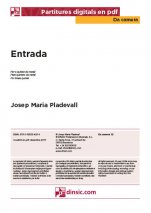Entrada

Inside Pages
Instrumental and vocal formations
Brass QuintetTechnical Specifications
Measurements
21 x 29,7 cm, vertical
Number of Pages
9
ISMN
979-0-69232-429-4
Editor
DINSIC Publicacions Musicals
Related Publications
Da Camera 12
Array
(
[Relacionat] => Array
(
[id] => 1330
[publicacion_id] => 12517
[publicacion_id1] => 2241
[type] => relacionada
)
[pub] => Array
(
[Publicacion] => Array
(
[id] => 2241
[titol] => Da Camera 12
[url] => score-dc12-da_camera_12
[codi] => DC12
[intro] =>
[continguts_generals] => The Set peces fàcils per a quintet de flautes de bec (Seven easy pieces for recorder quintet) were written with music students in mind. They are born of the need for uncomplicated music that sounds good in the classroom or in concert. An attempt has been made to allow each instrument its moment of protagonism, avoiding relegating them to simple accompanists to the leading voice.
The pieces can be interpreted separately. However, the tonal (and even thematic) approach permits interpretation of a whole unit of four movements. The possible inclusion of German Christmas songs in the 'Intermezzi' seems more fitting for Christmas concerts.
Likewise, according to the instruments available, there may be some modification in the formation of the brass quintet. Below are the possible variants: 1st voice, 1st trumpet; 2nd voice, 2nd trumpet; 3rd voice, 3rd trumpet or French horn; 4th voice, French horn or trombone; 5th voice, trombone or fiscorno (or tuba).
[estructuracio] => General score and separate part music.
[material_descarga] => 0
[titol_descarga] =>
[info_descarga] =>
[num_pags] => 20
[ismn] =>
[diposit_legal] =>
[codi_barres] =>
[isbn] => D.L.: B-2724-2001
[preu] => 19.71
[exhaurit] => 0
[oferta] => 0
[en_preparacio] => 0
[recomanat] => 0
[novetat] => 0
[format] => Partitura
[ctecnica] =>
[ilustracion] =>
[num_pagines_interiors] => 0
[n_pag_annex] =>
[numero_particelas] => 5
[numero_pagines_particelas] => 40
[durada] =>
[visible_instrumentacio] => 1
[visible_formacions] => 1
[pdf_car_estructuracio] => 0
[pes] => 0,120
[published] => 1
[created] => 2006-07-28 11:55:54
[modified] => 2025-05-16 17:44:28
[ordenacion] => 2006-07-28 11:55:54
[puntuacio] => 0.00
[visto] => 5446
[rating] => 0.0
[votes] => 0
[parent] =>
[has_child] => 0
[locale] => en_gb
)
[Audit] => Array
(
)
[Category] => Array
(
[0] => Array
(
[id] => 88
[url] => basico
[name] => Básico
[parent_id] => 78
[descripcio] =>
La clasificación del nivel de una partitura normalmente viene determinado por el grado de dificultad técnica del instrumento o voz. En los casos de obras para formaciones instrumentales diversas, orquestales, vocales, etc. el nivel se determina atendiendo a la complejidad general de la obra, no a la de sus instrumentos en particular. Es muy importante conocer este criterio porque las obras de conjunto aparecen también en los listados específicos de cada uno de sus instrumentos o voces que participan en él, pero el nivel que se indica es el de la formación instrumental-vocal.
[order] => 2
[lft] => 2
[rght] => 3
[published] => 1
[PublicacionsCategory] => Array
(
[id] => 269
[publicacion_id] => 2241
[category_id] => 88
)
)
)
[Idioma] => Array
(
[0] => Array
(
[id] => 116
[nom] => Catalan
[published] => 1
[url] => catalan
[PublicacionsIdioma] => Array
(
[id] => 401
[publicacion_id] => 2241
[idioma_id] => 116
)
)
[1] => Array
(
[id] => 103
[nom] => Castellà
[published] => 1
[url] => castella
[PublicacionsIdioma] => Array
(
[id] => 402
[publicacion_id] => 2241
[idioma_id] => 103
)
)
[2] => Array
(
[id] => 1724
[nom] => English
[published] => 1
[url] => english
[PublicacionsIdioma] => Array
(
[id] => 403
[publicacion_id] => 2241
[idioma_id] => 1724
)
)
[3] => Array
(
[id] => 142
[nom] => Music
[published] => 1
[url] => international
[PublicacionsIdioma] => Array
(
[id] => 9098
[publicacion_id] => 2241
[idioma_id] => 142
)
)
)
[Rsspost] => Array
(
)
[Archivesrelation] => Array
(
[0] => Array
(
[Archivesrelation] => Array
(
[id] => 1913
[model] => Publicacion
[foreign_id] => 2241
[order] => 0
[file_id] => 2517
[archivestypes_id] => 2
)
)
[1] => Array
(
[Archivesrelation] => Array
(
[id] => 1914
[model] => Publicacion
[foreign_id] => 2241
[order] => 0
[file_id] => 2518
[archivestypes_id] => 3
)
)
)
[PublicacionsIdioma] => Array
(
[Idioma] => Array
(
[id] => 116
[nom] => Catalan
[published] => 1
[url] => catalan
[locale] => en_gb
)
)
)
[path] => scores-elementary
)
20.50 €
Da Camera 12
16.68 €











